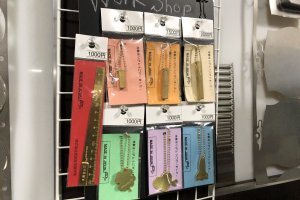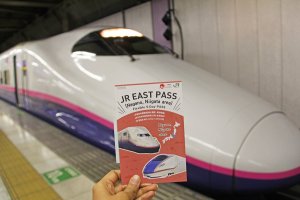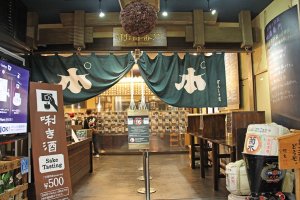The Northward Golden Route spans across Saitama, Gunma, and Niigata prefectures; if you enjoy nature, a bit of history, and hot springs, then you might want to consider this route as one of the more interesting ways to explore these prefectures close to Tokyo. In this feature, we introduce a model course for you to enjoy three fun-filled days in Niigata. From terraced rice fields to the Sea of Japan, from art installations dotting the landscape to a rich variety of sake, Niigata, often referred to as "snow country," is a delight to visit throughout the year.
With the Rugby World Cup just around the corner, this slightly-off-the-grid area might be ideal for an escape from Tokyo between matches. With excellent railway access from Tokyo, we take you step-by-step through what you can cover using the JR EAST PASS (Nagano, Niigata area) in Niigata prefecture.
Day 1

We started our journey from Ueno Station in Tokyo. We bought our JR EAST PASS at the JR EAST Travel Service Center just outside the central gates. The 14-day pass is flexible and valid for any five days starting from the day of issuance. To save some money, we suggest you buy it online in advance, simply bring a printout of your booking and exchange it for a pass.

With support in various languages, you can also pick up English brochures or ask for recommendations from the station staff at the JR EAST Travel Service Center about sightseeing in Niigata. If you don't have any idea about transport options in Niigata, we recommend getting details about Ekikara Kantakun, a taxi service that we used three times during this trip. Ready to depart, we hopped on the Toki 313 that took us from Ueno to Echigo Yuzawa in just over an hour.

Our first stop was Ponshukan, known to offer a myriad of nihonshu, commonly known as sake. Niigata's exemplary rice-producing environment is ideal for making delicious nihonshu—an aromatic drink made from rice, water, and koji (mold for fermentation). The sake varies depending on how much the rice grain is polished; Junmai Daiginjo is the highest grade of sake wherein about 50% of each rice grain is polished off.

At Ponshukan, there are a whopping 150 varieties of sake from local breweries. You can try many of the popular local sake by dispensing them from vending machines. For 500 yen, you can taste five varieties. We spent about half an hour comparing sake and thought this was an efficient way to acquaint ourselves with some of the local flavors before we chose one to buy.

Just outside the ticket gates, Ponshukan also has restaurants, souvenir shops, and even a sakeburo, where you can soak in a bath filled with hot water and sake. At the souvenir shops, you can choose from savory snacks like rice crackers, crockery, tote bags, soy sauce, and of course, sake. Our pick were these eco-friendly furoshiki (wrapping cloth) packets of rice produced in Niigata. You can even enjoy duty-free shopping here!
- Map
- Official Website (Japanese)

For lunch, we decided to try takeaway onigiri, a rice ball filled with condiments. Bakudan Onigiri, literally rice bomb, is a massive version of this commonplace snack. We picked the sizes, which have about 150g of rice and chose salmon and spicy miso (fermented soybean paste) from among sixteen fillings. With views of the rice fields, we enjoyed our onigiri on the Hokuetsu Express Hokuhoku Line and headed to Tokamachi Station, which has recently gained popularity due to the Echigo-Tsumari Art Triennale.

One of the great things about traveling in Niigata is the option to take a taxi service called Ekikara Kantakun. From Tokamachi Station, you can choose between three courses—two for three hours and one for an hour and a half. This is a hassle-free, economical option to cover all of the popular spots. We bought tickets for these at the JR EAST Travel Service Center at Ueno Station as there was English guidance; we could choose courses based on our budget and time restrictions. You can either keep your luggage in a locker at Tokamachi Station or take it with you in the taxi.

Since we wanted to take it easy, we chose a course that covers three terraced-rice fields (tanada in Japanese) and a beech forest. You can go to either exit of the station, show the ticket to a taxi driver and you're ready to go. Our first stop was Kamou no Tanada.

It took us about half an hour to reach this location. A quiet observation point offers a view of a few rice fields that get covered with water from snowmelt and rain alone. (Map)

The next field, Gimyou no Tanada, was about five minutes away by taxi, and is the smallest of the three. Perched at the edge of a main road, we got a peek into the lifestyle of farmers.

The most spectacular of the three is the Hoshi-toge no Tanada, as soon as you get out of the taxi, you are greeted with a view of about 200 cascading rice fields. With two observatories, we spent about 20 minutes here. The fields are an inspiring sight any time of the year: snow-edged in winter, charred brown in late autumn, mirroring the sky in late spring or early autumn, and lush green in summer. To avoid harming the crop, please don't enter any of the fields. (Map)

You can enjoy a variety of landscapes depending on the season and time of day.

One of the best times to visit is either early morning or late evening when the mist adds to the beauty of the landscape (Map).

Now that we knew where all the delicious sake of Niigata came from, it was time to visit Bijin Bayashi, which took about 25 minutes. A beech forest with trees that are about 100 years old, bijin means beautiful woman. The tall trees appear like silhouettes with the sunshine barely hitting the soft forest floor. Soak in the serene atmosphere with carp in the pond for company (Map).

By the time we finished the course and returned to Tokamachi Station, it was about 16:00. To reach Atema Plateau Resort Belnatio, we took a taxi up to this golf course resort just in time to enjoy the sun setting over the rolling green lawns. You can choose between western-style rooms or Japanese-western rooms that have a tatami-matted room. An ideal location for families or groups, you can enjoy walks on the periphery of the resort, cycle around the pond, or participate in seasonal events.

We chose the buffet dinner which was an excellent spread of western and Japanese dishes, including freshly fried tempura, sashimi (thinly sliced pieces of fish), lasagna, steak, and even a salad-and-dessert bar. Finally, there seemed to be no better way to end the day than relaxing in one of the natural hot spring baths, or you can use a private bath for an additional cost.
Day 2

After enjoying a lovely breakfast buffet, we took the free shuttle bus, reached Tokamachi station and decided to keep our luggage at the visitor center. Our tour choice for the morning was the three-hour Ekikara Kantakun course that covers some of the modern art installations in Tokamachi.

The first stop—just short of a 40-minute drive—is Kiyotsu Gorge Tunnel which offers majestic views of the unique columnar jointing rock formations. It took us about 30 minutes to walk the 750-meter long, multi-colored tunnel that has a calming effect as the sounds of nature and the installations merge.

You can gaze at the surreal reflections on suspended "drops" of water; relieve yourself in a one-way mirrored toilet cubicle with a view of the dramatic rocks; and be mesmerized by the infinite illusions of nature at the "Light Cave" reflecting the rocks and sky on the gently rippling water. If you want to walk to the lookout, wear waterproof shoes!
- Map
- Official Website (Japanese)

Our next stop is one of the most popular installations in the area called “For Lots of Lost Windows”. We climbed on the small platform and looked out at the panoramic view beyond the fluttering curtains. The natural setting results in individual and personal views wherein some people focus on the sky while others see more of the river. (Map)

Next stop, Potemkin, is an installation along the banks of the Kamagawa River made from large rusting iron sheets. Zen-like interiors with swings, pebbled paths, and mature trees offer shade and challenge you to contemplate the coexistence of man and nature. (Map)

Two installations within five minutes of each other, “Kiss & Goodbye” at Echigo Mizusawa Station is an arched cabin that looks like a train carriage. Here, you will find sculptures and murals based on the story of an orphaned boy who takes the train with his dog to visit his grandfather. (Map)

By the same Taiwanese artist, “Kiss & Goodbye” at Doichi Station has a mother and baby owl perched on top with colorful illustrations inspired by the same story. Both of these are currently closed, so you can't go inside either of them. (Map)
One of the main objectives of these art installations is to achieve a revitalization of life in the Tokamachi countryside. After an awe-inspiring morning with art and nature, we were dropped off at Tokamachi Station at noon.

We decided to have lunch at IKOTE, a stunning wooden structure shaped like a kamakura (snow hut) designed by Tezuka architects. Just a five-minute walk from the station, there is a restaurant with banquet tables on the first floor, where you can choose from a range of dishes featuring fresh local produce from Niigata; the second floor functions as a community space.

Our choice was the Tokamachi Osouzai Plate which included five assortments of miso-flavored salmon, tofu, grated radish and mushrooms in soy sauce, capsicum with white bait and sansho (Japanese variety of Sichuan pepper), and a tomato, bell pepper, pumpkin sauté. Each plate comes with miso soup, a bowl of rice, and pickles. (Map)

After lunch, we walked to Tokamachi Station, picked up our luggage and headed to Nagaoka Station using the JR EAST PASS. Nagaoka is known as the birthplace of colored carp and is host to one of the biggest firework displays in Japan. The station has a visitor center with English assistance. For the afternoon, we decided to do another three-hour Ekikara Kantakun course to discover some spots in Niigata.

Our first stop was Hasegawa-tei (Hasegawa Residence), rebuilt in 1716, this is the oldest private home in the Echigo area. The sight of a blue noren (split curtains) adorning the sturdy wooden entrance is an indication that this is not an ordinary home.

We learned about kayabuki-yane (thatched-roof houses), various traditional rooms, a fascinating Japanese-style toilet among other structural aspects of the house that gave us insight into the life of the Hasegawa family. Don't miss the intricate designs of the kugi-kakushi, decorative objects used to conceal the head of a nail.
- Map
- Official Website (Japanese)

As we drove toward our next destination, we could see the towering forked rooftops of the Houtoku Inari Taisha amidst the dense green. A complex of buildings and torii (red gates), the three gods of creation called Zoka Sanshin are enshrined here.

One of the few shrines in Japan where you write your wishes on candles—a way to connect to the kami (gods). We bought a set of five colored candles, each color having a meaning: green for traffic safety, health and education; red for business prosperity and financial success; yellow for fire prevention and a good crop; white for family well being; and purple for fulfilling one's wishes.
- Map
- Official Website (Japanese)

Our final stop on this course was Sara-no-Sato Asahiyama, a sake brewery first established in 1830 and known to be the oldest in Niigata. You can enjoy sake tasting for 300 yen; for 500 yen, you can taste, in addition to the Junmai Daiginjo-shu, exclusive sake that is only available here. We tried a range of their signature Kubota line, each with an elegant and refined flavor, that are ideal to pair with almost any kind of cuisine. You can buy bottles in various sizes and even get recommendations in English from the staff. You can also see the process of making sake during factory tours that are only possible in winter.
After picking some beautifully bottled nihonshu, the taxi driver dropped us off at Nagaoka Station from where we took a train and reached Iwamuro Station. To get to our ryokan, we had arranged for a pickup beforehand.

After a long day, we finally arrived at Yumotoya in the Iwamuro Onsen area at dusk. A kimono-clad okami (lady-in-waiting) greeted us and provided all the information we would need in English. We were lead to our rooms through warmly lit, wooden interiors, and intricate shoji screens. The profound silence was interrupted only by the clack of geta (wooden sandals).

Ryokan are traditional, Japanese-style inns usually with tatami-matted rooms, hot spring baths, and communal spaces. Normally, you won't see any beds, instead futon (thick mattresses) are laid out when you are having dinner; yukata, cotton kimono, are provided to each guest.

Dinner was a Japanese-style kaiseki meal, a banquet-like feast with an assortment of main dishes and sides served in seasonally inspired porcelain. The list of items was so long, here are a few of the main ones: Yotsuba pork with onions and corn in a light sweet sauce, steamed crab with pumpkin, tofu and potatoes, a cold chawanmushi (savory egg custard), assorted sashimi featuring the famous ama-ebi (sweet shrimp from Niigata), and grilled salmon with pickled onion. No better way to end a long day than excellent food followed by a soak in the gentle water of Iwamuro natural hot springs.

Caught in the surrounding sea, ama-ebi is also known as nanban ebi in Niigata. The shape and color of this shrimp resembles that of a red pepper. Sweet and succulent, you can find these in many delicacies in Niigata.
Day 3

We started our final day with a buffet breakfast at Yumotoya and booked a taxi to take us to Yahiko Shrine, which cost about 1700 yen. The surroundings of the historically significant Yahiko Shrine are thick with century-old zelkova and cedar trees. On the other side of the entrance torii is tama-no-hashi, a bridge for the gods across the Mitarashi stream.

As you walk in the dappled sunlight, it's not difficult to feel a sense of absolute tranquility. We cleansed ourselves at the temizuya, a stone basin with bamboo ladles, before continuing to the main shrine. The deity, Ameno Kagoyamano, was said to have taught people how to fish, make salt, and cultivate rice. Unlike most shrines where you bow twice, clap twice, bow once, in this shrine, you are expected to clap four times.
- Map
- Official Website (Japanese)

The last leg of our three-day trip is the area of Tsubame-sanjo, actually two adjacent cities, known for the finest metalwork in the country. From the shrine, we took a taxi to Yoshida Station and then used our JR EAST PASS to go up to Nishi-tsubame Station to visit the Takeda Kanagata Seisakusho.

Here, you can engrave your name on metal rulers, key chains, or phone straps for just for 1000 yen. We decided to try our hand at making our own personalized rulers with our names. It was quite interesting to see the various metal moulds that are used to create parts of many commonplace gadgets. The workshop is conducted only in Japanese.
- Map
- Official Website (Japanese)

While we wondered where to eat, the factory owner recommended we try a local specialty, Seabura Ramen, at Koushuhanten, which is said to be the origin of this comforting bowl of food. A five-minute walk brought us to a deceptively nondescript restaurant. Seabura means pork back-fat, which is used to make the soup along with dried fish. The pork back-fat maintains the heat of the soup preventing the thick noodles from going cold. If you have a big appetite, try the gyoza (dumplings) too. (Map)

Since we planned to return to Tokyo at around 15:00, we visited the Tsubamesanjo Regional Industries Promotion Center, just a short walk from the restaurant. Here, you can try your hand at spoon polishing and, with English support, it's a breeze to take part in this hands-on experience. The spoon polishing workshop costs just 300 yen; we were provided safety gloves, glasses, and an apron. The staff show you how to make a spoon shine so much so that you can see your reflection in it. The best part is that you get to keep the spoon for yourself.

Afterward, we spent time looking at the beautifully crafted metal products ranging from beaten copperware to knives. With so much variety, you may feel it’s difficult to choose; our personal favorite was the Gyokusendo copper tea canisters. Even the cutlery used for Nobel Prize banquets comes from this region, no wonder Tsubame-sanjo is called the "city of craftsmanship." There is duty-free shopping available here as well as a place to keep your luggage for free!

Happy with our purchases, we made our way to Tsubame-Sanjo Station and hopped aboard the MAX Toki 328. It took us less than two hours to reach the jostling crowds of Tokyo Station. Some of these spots are a bit far and it's safe to say these hidden gems of Japan could easily be overlooked. How about exploring the natural beauty of Japan with snippets of history and traditional crafts?
(Prices and information as of June 2019)
This is the third part of a series about traveling along the Northward Golden Route covering Saitama, Niigata, and Gunma prefectures. If you want to see more photos of this amazing trip, do check the photo gallery on the right.


































